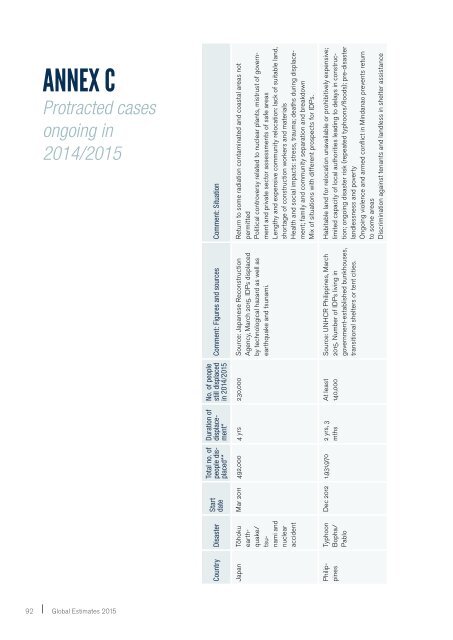ANNEX CProtracted casesongoing in2014/2015Comment: Figures and sources Comment: SituationNo. of peoplestill displacedin 2014/2015Duration ofdisplacement*Country DisasterTotal no. ofpeople displaced**StartdateReturn to some radiation contaminated and coastal areas notpermittedPolitical controversy related to nuclear plants, mistrust of governmentand private sector assessments of safe areasLengthy and expensive community relocation: lack of suitable land,shortage of construction workers and materialsHealth and social impacts: stress, trauma; deaths during displacement;family and community separation and breakdownMix of situations with different prospects for IDPs.Mar 2011 492,000 4 yrs 230,000 Source: Japanese ReconstructionAgency, March 2015. IDPs displacedby technological hazard as well asearthquake and tsunami.Habitable land for relocation unavailable or prohibitively expensive;limited capacity of local authorities leading to delays in construction;ongoing disaster risk (repeated typhoons/floods); pre-disasterlandlessness and povertyOngoing violence and armed conflict in Mindanao prevents returnto some areasDiscrimination against tenants and landless in shelter assistanceJapan Tōhokuearthquake/tsunamiandnuclearaccidentSource: UNHCR Philippines, March2015. Number of IDPs living ingovernment-established bunkhouses,transitional shelters or tent cities.At least140,000PhilippinesTyphoonBopha/PabloDec 2012 1,931,970 2 yrs, 3mths92 Global <strong>Estimates</strong> 2015
Country DisasterStartdateTotal no. ofpeople displaced**Duration ofdisplacement*No. of peoplestill displacedin 2014/2015Comment: Figures and sources Comment: SituationHaiti EarthquakeJan 2010 Up to2,300,000(1,500,000in campsas of July2010)5 yrs, 2mthsAt least64,700Source: IOM's displacement trackingmatrix (DTM), March 2015. IDPs stillliving in registered camps only. Numberof people still displaced outsidecamps is unknown.Chronic poverty, state fragility and disaster riskExtensive destructionInvisibility of IDPs among urban poor;Complex, informal land tenure; Discrimination against tenants andinformal settlers; Forced evictions and camp closuresWeak linkages between humanitarian assistance and long-termdevelopmentUnitedStatesHurricaneSandyOct 2012 775,761(430,675in NewJersey)2 yrs, 4mthsAt least39,200Source: Fair Share Housing, LatinoAction Network, and New JerseyNAACP report, February 2015. Basedon 14,650 families in NJ who haveapplied, are eligible and are awaitinggovernment financial housing support.An underestimate as only includeshomeowners and not renters. Doesnot include those still in need of housingsupport but who did not apply.Land use and zoning barriers; lack of transparency and access toinformationLack of long-term assistance based on assumption that displacementis short-term and temporaryForced evictions of some low-income families in mobile home communitiesDiscrimination in share of initial recovery funds distributed to tenantsand homeowners; discrimination against African Americanand Latino homeowners seeking assistance to rebuild; discriminationin access to information for people with limited proficiency inEnglishPakistan MonsoonfloodsSept20121,856,570 1 yr, 9 mths 31,000 Source: Pakistan shelter cluster, June2014. Number of beneficiaries of transitionalshelters in 2014.Repeated exposure to hazards and flood displacementLack of land; limited technical proficiency for reconstruction; highcost of materialsDiscrimination towards those with limited literacy; discrimination inaccess for female heads of householdMozambiqueFloods Jan 2013 130,000 1 yr, 3 mths 26,000 Source: IOM Field Office interview,April 2015. Number of IDPs awaitingplots of land for relocation. Same IDPsfinally allocated sites in December2014.Exposure to additional hazards (recurrent floods); limited desirableland available in relocation sites; delays in relocation processContinued repeat displacement caused by recurrent floodsDiscrimination in access to services such as schools and hospitalsAnnexes93
- Page 1:
Global Estimates 2015People displac
- Page 4 and 5:
IDMC core project teamCoordinator/l
- Page 7 and 8:
5. Mind your assumptions: Protracte
- Page 9 and 10:
FIGURES, TABLES AND MAPSFigure 2.1:
- Page 11 and 12:
Modelled global displacement trend
- Page 13 and 14:
1INTRODUCTIONSince 2008, an average
- Page 15 and 16:
2CONCEPTUALISINGDISPLACEMENTin the
- Page 17 and 18:
Box 2.1: Slow-onset hazards and gra
- Page 19 and 20:
Repeated and frequent displacementR
- Page 21 and 22:
3THE GLOBAL PICTUREScale, patterns
- Page 23 and 24:
Figure 3.2: Global displacement by
- Page 25 and 26:
Box 3.1: “Super” El Niño and d
- Page 27 and 28:
While more resilient families may b
- Page 30 and 31:
28 Global Estimates 2015A woman sta
- Page 32 and 33:
4.1 RegionsAs in previous years, As
- Page 34 and 35:
4.2 CountriesThe number of people d
- Page 36 and 37:
forward, the municipalities of Pasc
- Page 38 and 39:
4.4 The big three: China, India and
- Page 40 and 41:
Map 4.1: Philippines regions affect
- Page 42 and 43:
Displacement caused by seasonalfloo
- Page 44 and 45: 4.6 Multiple hazards in fragile and
- Page 46 and 47: SPOTLIGHTAFGHANISTANBlurred lines b
- Page 48 and 49: 46 Global Estimates 2015A displaced
- Page 50 and 51: The global data presented in this r
- Page 52 and 53: The international experts we interv
- Page 54 and 55: perstorm Sandy in 2009, and indigen
- Page 56 and 57: SPOTLIGHTPAPUA NEW GUINEAManam isla
- Page 58 and 59: SPOTLIGHTINDONESIASidoarjo mudflow
- Page 60 and 61: SPOTLIGHTBANGLADESHSix years after
- Page 62 and 63: Figure 5.4: Movement of IDPs from a
- Page 64 and 65: SPOTLIGHTHAITIChronic vulnerability
- Page 66 and 67: Conditions have continued to deteri
- Page 68 and 69: Map 5.3: Ongoing displacement in th
- Page 70 and 71: The mental and physical health ofID
- Page 72 and 73: SPOTLIGHTUNITED STATESDisplaced peo
- Page 74: assistance available and implementa
- Page 77 and 78: 6THE POST-2015GLOBAL POLICYAGENDAKe
- Page 79 and 80: A landslide devastated villages in
- Page 81 and 82: ANNEX AMethodologyIDMC’s annual G
- Page 83 and 84: protracted displacement situations
- Page 85 and 86: Data on housing rendereduninhabitab
- Page 87 and 88: Modelling and calibration usingthe
- Page 89 and 90: We also asked each interviewee toth
- Page 91 and 92: RankingCountry Hazard Affected area
- Page 93: * Text in parentheses indicates the
- Page 98 and 99: Country DisasterStartdateTotal no.
- Page 100 and 101: Country DisasterStartdateTotal no.
- Page 102 and 103: REFERENCESSection 21. UNISDR, Termi
- Page 104 and 105: 34. NDRRMC, SitRep No.27 re Effects
- Page 106 and 107: nation Group, October 2009, availab
- Page 108: digidepo_8841940_po_076709.pdf?cont


